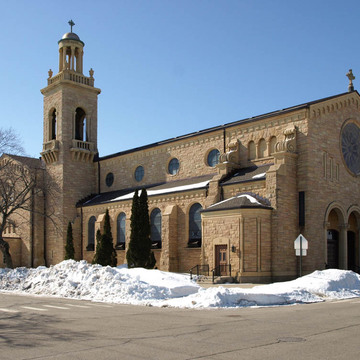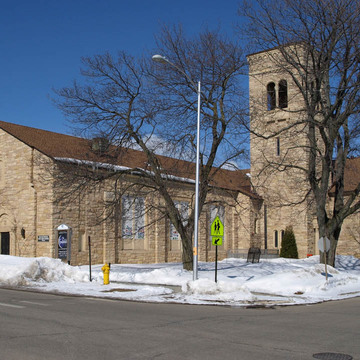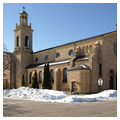You are here
St. Joseph and St. Patrick Church and William Bonifas Fine Arts Center (St. Joseph's Church, Memorial Building, and Auditorium)
Gifts from lumberman William Bonifas (1865–1936) and his wife, Catherine (1868–1948), financed in large part the construction of St. Joseph's Church and the combination auditorium and gymnasium that is now the William Bonifas Fine Arts Center. The Green Bay, Wisconsin, architects designed the buildings in Romanesque Revival. The buttressed exterior walls of the buildings are pale yellowish-brown stone from Kasota, Minnesota. A campanile rises in the angle at the crossing of the church's nave and the east transept. A rose window pierces the north wall above the triple-arched recessed entrance that is supported by Romanesque columns with foliated capitals. The interior is embellished with black, buff, rose, and salmon marbles, as well as mosaics and stained glass. A tower stands at the intersection of the auditorium/gymnasium. This lavish religious complex that replaced an earlier red and yellow brick Gothic Revival church (1873, Carl F. Struck) is evidence of the importance of Escanaba to the Upper Peninsula. Some call Escanaba Michigan's third capital, after Marquette. In 1997 the Marquette Diocese merged the church with St. Patrick Church.
Writing Credits
If SAH Archipedia has been useful to you, please consider supporting it.
SAH Archipedia tells the story of the United States through its buildings, landscapes, and cities. This freely available resource empowers the public with authoritative knowledge that deepens their understanding and appreciation of the built environment. But the Society of Architectural Historians, which created SAH Archipedia with University of Virginia Press, needs your support to maintain the high-caliber research, writing, photography, cartography, editing, design, and programming that make SAH Archipedia a trusted online resource available to all who value the history of place, heritage tourism, and learning.





